- Home
- Technical Cooperation Projects
- Index of Countries
- Africa
- Mozambique
- Project on Strengthening Resilience in Cyclone IDAI-Affected Areas
- Project News
- The 1st training in Japan - Story in the Tohoku Region 2: Town development for reconstruction and lesson from livelihood recovery project (Feb. 23 to 24, 2020) -
Project News
2020-04-30
The 1st training in Japan - Story in the Tohoku Region 2: Town development for reconstruction and lesson from livelihood recovery project (Feb. 23 to 24, 2020) -
The participants visited three cities, including Sendai, Ishinomaki, and Natori, together with Minami-Sanriku Town in Miyagi Prefecture, from February 20 to 24, 2020 in order to deepen understanding of reconstruction planning after earthquake disasters, town development and livelihood recovery in Tohoku Region.
The participants visited three areas in Miyagi Prefecture from February 20 to 24, 2020 including Sendai City, Ishinomaki City, Natori City, and Minami-Sanriku Town in order to understand reconstruction planning after earthquake disasters, town development and livelihood recovery in Tohoku Region. This article covers stories from February 23 to 24, 2020.
Activities in shopping street and leadership toward reconstruction (Feb. 23, 2020)
Minami-Sanriku, featuring a deeply indented coastline, is a town damaged by huge tsunamis once in 40 years. The participants learned about reconstruction efforts in Minami-Sanriku Town through the guide from Mr. Kenji Endo, who once served as deputy town head of Minami-Sanriku and now works as a Director of Minamisanriku Learning Center. In the morning, they visited Togura Junior High School (which was devastated by the earthquakes), the disaster reconstruction memorial park (former government building for disaster prevention), Shizugawa Junior High School (which was functioned as an evacuation center), and the Sansan Shopping Street as a role model for industrial recovery. During the visit, they learned how to pass disaster lessons on to future generations and create branded food items (such as Kirakira Don, or rice bowl topped with attractive local seafood like sea urchin and salmon roe) and souvenirs with local specialties. They also learned a mechanism of the private sector activity and cooperation for recovery and reconstruction. Because Togura Junior High School was stricken by a 22.6m high tsunami, Mr. Endo explained, as a keyword to develop the town for reconstruction, that "livelihood is placed in a wide variety of locations, though residence should be built on the hill."
In the afternoon, they attended a lecture by Mr. Endo. The lecture covered leadership towards reconstruction, request for support at the administrative level in disasters, cooperative system between administrative agencies across Japan, and administrative disaster prevention agreement at Minamisanriku Learning Center. Many questions were asked during the Q&A session, such as "How did the city officials get information to distribute to the media? How were the locations selected for reconstruction housing? Was financial support given to disaster-affected families for relocation?"
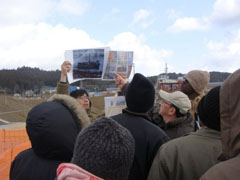 Participants briefed by Mr. Endo about the disaster situation at the Reconstruction Memorial Park.
Participants briefed by Mr. Endo about the disaster situation at the Reconstruction Memorial Park.
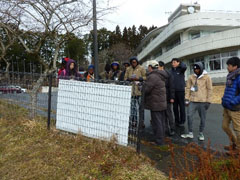 Tainees at Shizugawa Junior High School.
Tainees at Shizugawa Junior High School.
Manufacturing and livelihood recovery by utilizing local resources (Feb. 24, 2020)
In the morning, the participants visited and observed a factory producing "Kamaboko" (processed fish paste product) in Oizen Shoten. They learned from the CEO, Mr.Zenyu Oikawa that how private companies actually coordinated and consulted with the resident's community and the town administration for the development and efforts for earlier business recovery. After participants tasted Kamaboko, Mr. Oikawa asked them if Kamaboko was tasty. One trainee answered, "Although it is my first time to taste it, it is delicious. I believe Kamaboko can be sold well in Mozambique, too. There is a fish that can be used for Kamaboko in Mozambique." In the afternoon, they visited Yes Factory, which produces local specialties and products made of timber from forest thinning. The Head of Yes Factory, Mr.Tadayoshi Abe, lectured on securing employment in the town, creating a venue for social interaction, producing souvenirs with local resources, and promoting livelihood recovery at the civil society level. The participants, observing the factory, are interested in laser and silkworm cocoon-based crafts and bought T-shirts, button badges, and strips for the region's signature character "Octopus-kun," and other design items as souvenirs for themselves and their families. Furthermore, one participant said, "Mozambique's representative flower is designed on this fabric. Can this design be used for the laser craft?" Mr. Abe replied, "This design is beautiful. Laser craft is possible with these kinds of designs. Collaborative work would be interesting in the future." A trainee, who bought a button badge of Octopus-kun, has worn it on his jacket all the way through the training.
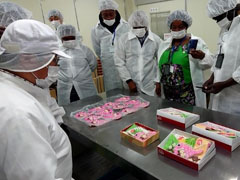 The participants being lectured about hygiene management or packaging and Kamaboko production process, including product development idea by Mr. Oikawa.
The participants being lectured about hygiene management or packaging and Kamaboko production process, including product development idea by Mr. Oikawa.
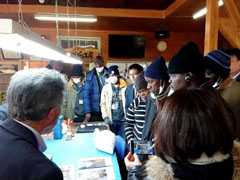 The participants being explained to about cocoon-based crafts by President Oikawa.
The participants being explained to about cocoon-based crafts by President Oikawa.
- Highlights -
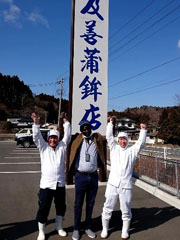 After group photo, a commemorative photo session was started with Mr.Oikawa and his son. Center is Samuel.
After group photo, a commemorative photo session was started with Mr.Oikawa and his son. Center is Samuel.
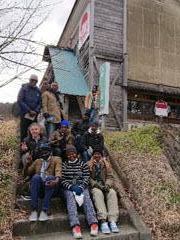 Do you know the origin of the name "Yes Factory"? Actually, an abandoned school building has been used for the center. The term "abandoned school" means "haiko" in Japanese. The word "hai" in Japanese is "Yes" in English. This is the story of how the Yes Factory was named. This kind of word games are all over the factory, which gave a challenging task to the interpreter.
Do you know the origin of the name "Yes Factory"? Actually, an abandoned school building has been used for the center. The term "abandoned school" means "haiko" in Japanese. The word "hai" in Japanese is "Yes" in English. This is the story of how the Yes Factory was named. This kind of word games are all over the factory, which gave a challenging task to the interpreter.
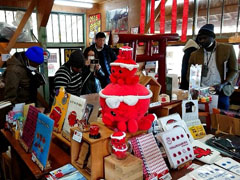 Participants selecting souvenirs. Octopus-kun goods and T-shirts were popular among the participants.
Participants selecting souvenirs. Octopus-kun goods and T-shirts were popular among the participants.
- About JICA
- News & Features
- Countries & Regions
- Our Work
- Thematic Issues
- Types of Assistance
- Partnerships with Other Development Partners
- Climate Change / Environmental and Social Considerations
- Evaluations
- Compliance and Anti-corruption
- Science and Technology Cooperation on Global Issues
- Research
- JICA Development Studies Program / JICA Chair
- Support for the Acceptance of Foreign HRs / Multicultural and Inclusive Community
- Publications
- Investor Relations
